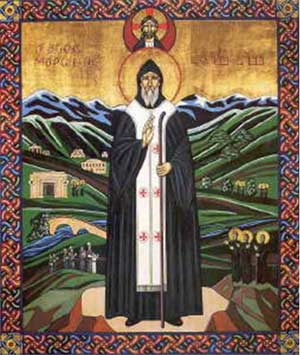Part Three: Matti Moosa on St Maroun
In The Maronites in History, Matti Moosa argues that we know nothing of any “Maroun” who was related, in any way, to what became the Maronite Church.
Moosa argues, at p. 27, that the letter to Maroun by John Chrysostom “is so generalized and superficial that it could never have been written by Chrysostom, a distinguished Biblical scholar and orator.” His argument runs like this:
*1. Distinguished biblical scholars and orators only write letters which are not generalized and superficial.
2. This letter is generalized and superficial.
3. Therefore a distinguished biblical scholar and orator cannot have written this letter.
I have marked the first point with an asterisk to show that it is not stated by Moosa, but must be true for his argument to be persuasive. But immediately two problems present themselves for Moosa’s argument: first, how does he know what a “distinguished biblical scholar and orator” will or will not write, and second, what does Moosa mean by “generalized and superficial”?
We learn what a “distinguished biblical scholar and orator” will or will not write by looking at what they actually did write. If we compare the letter to Maroun with Chrysostom’s letter to Castus, Valerius, Diophantus, Cyriacus, Presbyters of Antioch, we do not find any more biblical scholarship or oratory in that letter. St John was perfectly capable of writing to his friends in a manner which I would call not “general or superficial”, but rather, personal and full of affection rather than learning.
The letter to St Maroun is intended to assure him that Chrysostom loves him , and beseeches Maroun to pray for him. Is it not the mark of a scholar and orator to deliver such a simple message with simplicity? So I would actually argue that the directness and unaffected emotion of the letter support the view that it was by Chrysostom.
Moosa’s argument is no argument at all: it amounts to saying that a biblical scholar will only write learned works, and an orator can never speak simply. That there is no other evidence of the friendship between the two saints is hardly surprising: since Chrysostom addresses Maroun as a hermit, it is at least likely that he met him when he was a hermit. What record should there be of one man visiting a hermit? Does Moosa seriously suggest that we have evidence of everyone whom Maroun and Chrysostom ever met?
Moosa goes on to note that the most important source for the hermit Maroun is the life by Theodoret. Moosa states that Theodoret: “… affords Mar(o)un no special place or excellence in the austere life practised by thousands of monks and holy men …” (p. 18).
Of course, Moosa does not quote Theodoret, because if he did, this would immediately show that Moosa’s comments are wrong to an extent which is almost bizarre. Theodoret, as we saw in Part 1, stated: “I will call to mind Maroun, for he adorned the godly troop of the holy ones. … Maroun did not only employ the customary labours, but he conceived others also … so richly did the munificent one grant to him the charism of healing, that Maroun’s fame ran about everywhere, and everyone from everywhere was attracted, so that experience taught them the truth of the report.”
Moosa states: “… nothing in his (Theodoret’s) work suggests that Maroun had achieved such a high degree of piety as to gain him the eminent position attributed to him by later Maronite writers” (p. 19). But Theodoret wrote this: “Maroun cultivated many crops through his wisdom: it was he who planted the paradise which now blooms in the land of Kurros (Cyr). The great Yakobos (James) was a product of this cultivation: of him and of all the others whom I shall recall individually with God’s help, one could rightly apply the famous prophetic saying: “The just man will flower like the palm tree, and will be multiplied like a cedar in the Lebanon.”
I am sorry to say this, but given that Theodoret specifically states that St Maroun planted the monastic movement in that region, I cannot draw any conclusion except that Moosa deliberately fails to quote him because he knew full well that his statements about St Maroun were plain wrong.
Some of Moosa’s comments about errors made by Maronite historians being wrong may be better founded. But wherever I could check these Maronite writers, they were proposing hypotheses. There is nothing wrong with doing that, but just because a thesis connected with St Maroun is wrong, it does not mean that nothing is known of him. The facts are as stated in Part 1 of this series.
Chapter 2 of Moosa’s book, on St Maroun, has been sufficiently answered. There is no good reason at all to deny that St Maroun the hermit mentioned by Theodoret is the Maroun whose name was given to the monastery of St Maroun, as contended by Abbot Paul Naaman in his book The Maronites.
Joseph Azize, 8 April 2017 (Lazarus Saturday)
